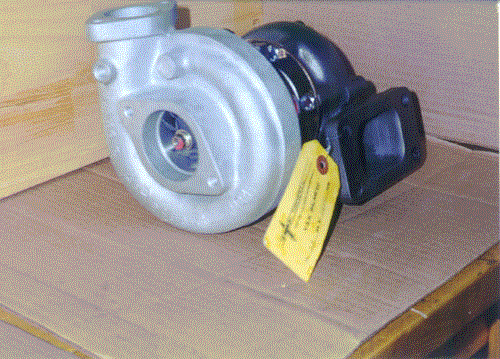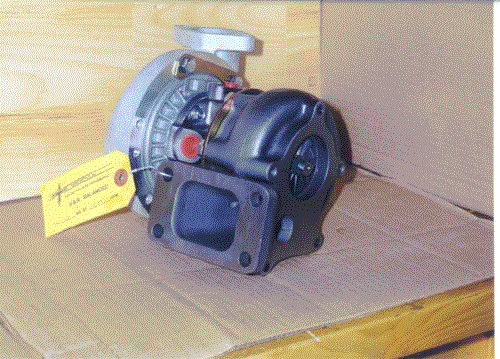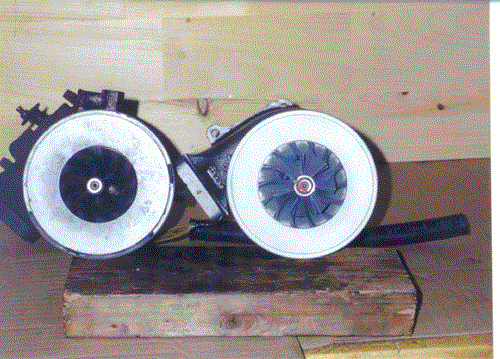

A few people have asked me where to get a T3/T4. If you feel you have good mech ability, you can build one yourself. You will need to purchase the following; Compressor housing #318-109 $68.75 Compressor wheel #318-105 $95.00 Seal Plate #318-112 $60.00 Repair kit #300-400 $90.00 (if I remember correctly) Available from TurboCity -Orange -CA.
Strip turbo, and clean well. Cleanliness is proportional to longevity. THE CLEANER THE BETTER. NEVER scratch the turbine or shaft or compressor - it WILL FAIL. You will get all necessary seals and new bearings in the seal kit. Follow all assembly instructions you get with kit.
CRITICAL; Compressor wheel nut. Tighten to 18 inch-lbs, then 1 additional 1/4 turn. OR If have a large micrometer or bolt stretch gauge, then tighten nut for shaft stretch of .0055 to .0065 inch.
The hybrid spools up slower, but makes cooler air (and lots of it).
If you just want to overhaul your T3, then just get the kit.
Before you disassemble, mark position of compressor wheel on shaft
(very small nick) Reassemble in same position for best balance.
Several months earlier, I had researched different sources for turbocharger rebuilds. I figured that my turbo would eventually need to be rebuilt, so I wanted to have a plan in place. This way, I wouldn't have to scramble and make a rush decision when my turbo did go out. I won't go into all the details of the "other places", but I will share with you the place that clearly stood out as the best choice for me.
Let me start by saying I am not into advertising for this or any other company. I am just a satisfied customer. They did an excellent job at a reasonable price, and they are worthy of a good recommendation. The shop I chose was Turbonetics in Moorpark, California. They have been around for 20 years, and have a growing reputation among automobile racers. I was very impressed with their work and service. Below are some photos of the rebuilt turbo I received. It may not be clear from the photo, but they surface ground the mating surfaces on the turbine housing to ensure their flatness. The turbo looked like new.


Of course, looks aren't everything, and what's on the inside is most important... As you may know, standard turbo oil ring seals have a straight end gap (similar to conventional piston rings). This straight gap can allow oil to get past and into the compressor housing. Turbonetics uses a staggered gap oil ring which they developed. This design is supposed to eliminate the oil consumption problem. In addition, Turbonetics installs a heavy duty thrust bearing. Another bonus is that they have a V.S.R. turbocharger console, which allows them to test the center rotating assembly at operating speeds. They are able to dynamically check the turbo at real life operating speeds. In addition, Turbonetics does what they call a "Competition Balance" where they claim a resultant assembly balance four times better than allowable factory spec's. If you've read very many magazine articles of hi-performance street/race cars, you will often read about Turbonetics turbos being used. There must be a good reason for this.
Since my compressor wheel was chewed up, I decided to upgrade to a Buick Grand National (GN) compressor wheel. The GN wheel is a custom compressor wheel that doesn't fit into any of the standard "T" categories. I was told that it is comparable to a T-4 wheel (between S & V trim). The GN wheel has 0.400 inch larger major diameter and approximately 0.100 larger minor diameter. You can see the difference in the photo below...

The compressor housing must be machined to accommodate the larger GN wheel. I was told that this combination is supposed to flow enough air to produce 310-315HP - a nice improvement over stock.

Now, for the good news...PRICE. When I spoke with Turbonetics about an estimate, I was quoted approximately $450 (assuming the turbo doesn't have any unusual damage). I felt this was a very reasonable price. When it was all said and done, my turbo rebuild/upgrade came out to be $442.14. This included the cost of the new GN compressor wheel, all other parts, & labor time. My turbo had 2 bolts busted off in the turbine housing, so it required some extra shop time to remove these ($45). If I didn't break off these bolts, the total charge for the rebuild/upgrade would have been UNDER $400! Shop around and try to find as much turbo for a better price...Turbonetics gives you a lot for the money.
By the way, if you are getting your turbo rebuilt, I'd recommend that you do not try to remove the exhaust elbow. I did this thinking I would save some $ by reducing shipping weight, but in the end it cost me extra because of the busted bolts. Turbonetics has certain "tricks of the trade" they use to remove frozen bolts, so it may be best to let them remove the elbow. In addition, they probably would surface grind the elbow mating surface ensuring a better seal with the turbine housing.
I dealt with Brad at Turbonetics and he was very helpful. In case you're interested, here's some company info ...
Turbonetics, Inc.
5400 Atlantis Ct.
Moorpark, CA 93021
(805) 529-8995
http://www.turboneticsinc.com
Technically, there is supposed to be no break-in period required on a turbo, but being cautiousI have decided to take it easy for at least a few days. Right now, I have boost pressure set to around 9psi. The car runs great and feels mildly strong. Soon I will be turning up the boost and then the real fun will begin!! In the near future, I hope to add the following information to this write up....
Charge air temp comparison between Stock T-3 and GN compressor wheels G-Tech HP figures for stock T-3 vs Upgraded turbo Seat O' the Pants driving impressions........

